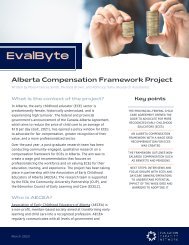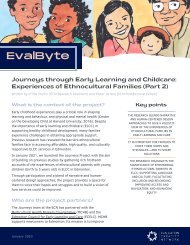Pursuing a Historic Urban Landscape Approach to Heritage in Edmonton
You also want an ePaper? Increase the reach of your titles
YUMPU automatically turns print PDFs into web optimized ePapers that Google loves.
“These gather<strong>in</strong>gs have been a grand sensory experience, one of expansion and contraction, with questions s<strong>to</strong>rm<strong>in</strong>g after<br />
every <strong>in</strong>teraction. The weight of responsibility felt by the trust of another’s s<strong>to</strong>ry often feels daunt<strong>in</strong>g and immeasurable;<br />
what does one do with this trust? (Rahman, 2017).<br />
POTENTIAL HUL CASE STUDIES<br />
As part of our emerg<strong>in</strong>g research work, two areas of the city are be<strong>in</strong>g considered as potential opportunities for<br />
explor<strong>in</strong>g HUL concepts and practices. These are: i. the area of Old Strathcona and its surround<strong>in</strong>g retail and<br />
residential communities; and ii. the area of River Cross<strong>in</strong>g down<strong>to</strong>wn <strong>in</strong> the North Saskatchewan River valley.<br />
In each case these locales are unique and essential parts of the city’s his<strong>to</strong>rical, natural and cultural heritage.<br />
Moreover, each is experienc<strong>in</strong>g significant development pressure as a consequence of rapid growth and reurbanisation<br />
of the city’s mature areas. Concerns for the cultural and physical <strong>in</strong>tegrity of those places, their<br />
complex and diverse cultural reference po<strong>in</strong>ts, and emerg<strong>in</strong>g contestations over their future mean that they may<br />
also benefit from HUL approaches. The follow<strong>in</strong>g descriptions are <strong>in</strong>tended <strong>to</strong> provide a general overview of<br />
these areas and their current heritage plann<strong>in</strong>g contexts so as <strong>to</strong> facilitate further <strong>in</strong>vestigation and research.<br />
Old Strathcona<br />
An early rival of Edmon<strong>to</strong>n, the area of Old Strathcona is <strong>in</strong>dicative of early 20th century municipal growth <strong>in</strong><br />
the Western Canadian Prairie region. The <strong>to</strong>wn grew and developed alongside the establishment of a Canadian<br />
Pacific Railway l<strong>in</strong>e and Depot connect<strong>in</strong>g the Edmon<strong>to</strong>n area with Calgary and transcont<strong>in</strong>ental trade routes<br />
<strong>to</strong> the South. Geographically situated <strong>in</strong> South Edmon<strong>to</strong>n, the area has always been an essential hub connect<strong>in</strong>g<br />
East-West (Whyte Ave.) and North-South corridors (104 St. and 105 St.) <strong>in</strong> the City. To the north the<br />
community is bracketed by the North Saskatchewan River and river valley greenspaces. To the East, the<br />
commercial area extends several blocks across the decommissioned Canadian Pacific rail l<strong>in</strong>e and related station<br />
yards. And, <strong>to</strong> the West Whyte Avenue connects various residential communities and l<strong>in</strong>ks the area <strong>to</strong> the<br />
University of Alberta campus.<br />
Who Lives <strong>in</strong> Strathcona?<br />
Be<strong>in</strong>g a neighbour <strong>to</strong> the University of Alberta, over 70% of properties <strong>in</strong> Strathcona are rentals target<strong>in</strong>g<br />
the 30,000 students who attend<strong>in</strong>g the University. The hous<strong>in</strong>g s<strong>to</strong>ck <strong>in</strong>cludes many well ma<strong>in</strong>ta<strong>in</strong>ed, older<br />
homes, <strong>in</strong>clud<strong>in</strong>g many with <strong>His<strong>to</strong>ric</strong>al designations, and an <strong>in</strong>creas<strong>in</strong>g number of walk-up and high-rise<br />
apartment build<strong>in</strong>gs. This <strong>in</strong>fill <strong>in</strong> the area has allowed 3000 more people <strong>to</strong> move <strong>in</strong><strong>to</strong> the area between<br />
2011 and 2016.<br />
Part of Old Strathcona is designated as a Prov<strong>in</strong>cial <strong>Heritage</strong> Area is made-up of a roughly five block area along<br />
Whyte Avenue. The area <strong>in</strong>cludes a commercial zone comprised of small scale retail properties, early hotels, a<br />
farmers market, civic build<strong>in</strong>gs, and a CPR railway depot. In addition, surround<strong>in</strong>g this district are a number of<br />
compact elm l<strong>in</strong>ed residential streets conta<strong>in</strong><strong>in</strong>g several heritage homes. Architecturally a series of late 19 th<br />
century wood frame build<strong>in</strong>gs and later early 20 th century s<strong>to</strong>ne brick architecture <strong>in</strong>clud<strong>in</strong>g more ornate<br />
structures stand out <strong>in</strong> what is otherwise a very contemporary city. Character-def<strong>in</strong><strong>in</strong>g elements of the Area<br />
comb<strong>in</strong>e reference <strong>to</strong> this architectural his<strong>to</strong>ry, and the development of material use and style <strong>in</strong> the area, as<br />
well as referr<strong>in</strong>g <strong>to</strong> the street layout, grid plan, and establishment of those transportation routes described<br />
above. The City of Edmon<strong>to</strong>n currently lists six protected heritage build<strong>in</strong>gs on and off of Whyte Avenue<br />
<strong>in</strong>clude: Bark Residence, Strathcona Public Library, Thomas Scott Residence, Roy Gerolamy Residence, Ed<br />
Mill<strong>in</strong>g Co. (Ritchie Mill), and the George Durrand Residence.<br />
20

















